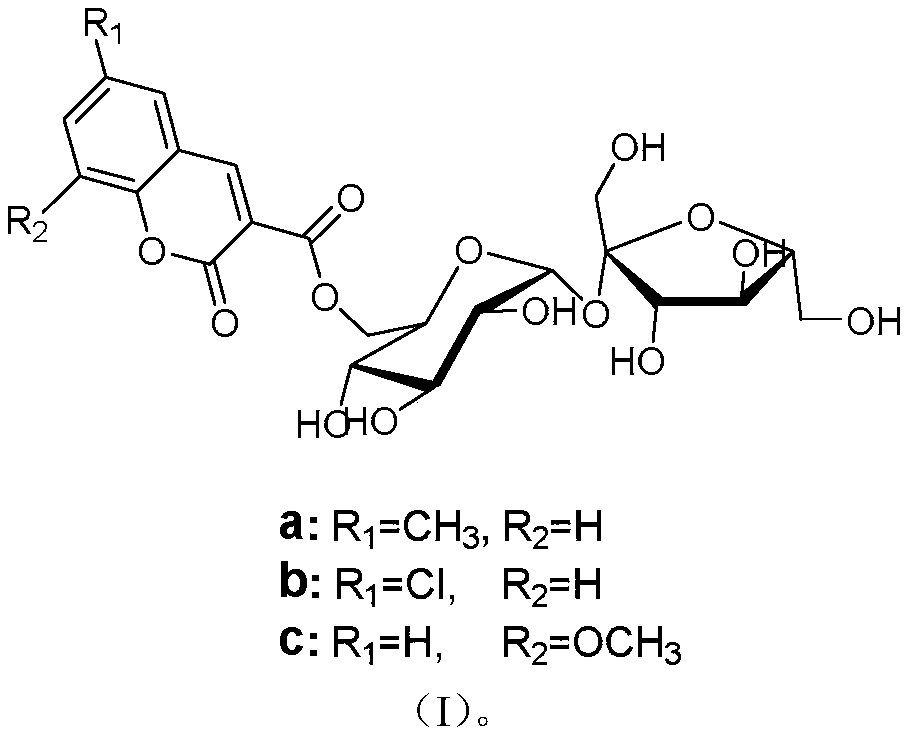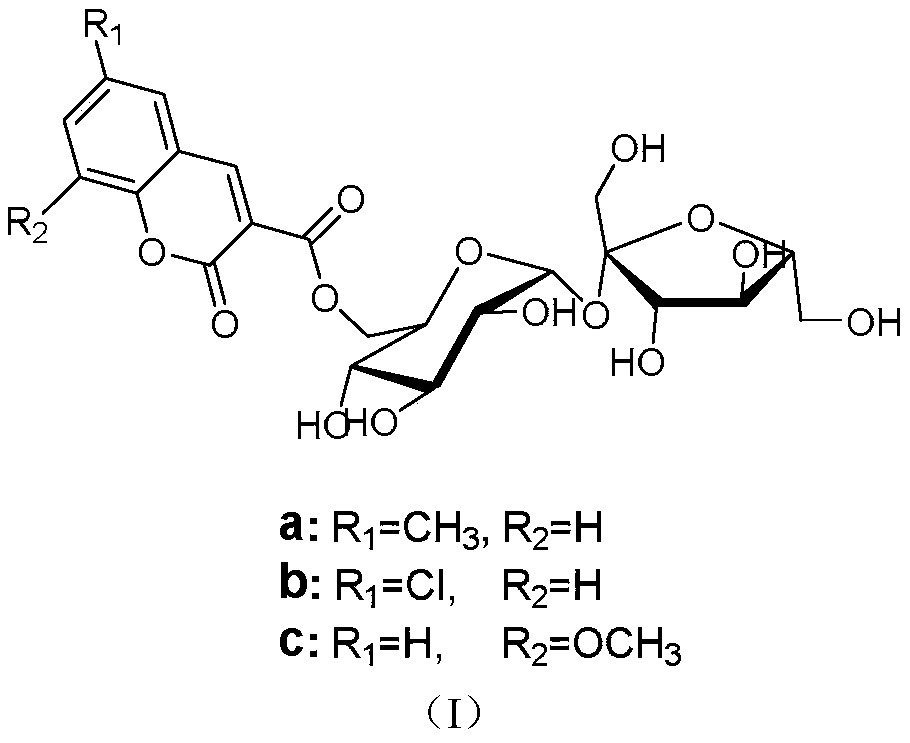Method for online enzymatic synthesis of coumarin-3-carboxylic acid-6'-O-D-sucrose ester derivative based on flow chemistry
A technology of enzymatic synthesis and flow chemistry, applied in chemical instruments and methods, biochemical equipment and methods, chemical/physical processes, etc., can solve problems such as long reaction time, reduce reaction cost, shorten reaction time, and achieve high conversion Rate and selectivity effects
- Summary
- Abstract
- Description
- Claims
- Application Information
AI Technical Summary
Problems solved by technology
Method used
Image
Examples
Embodiment 1
[0027] Example 1: Synthesis of 6-methylcoumarin-3-carboxylic acid-6'-O-D-sucrose ester
[0028]
[0029] device reference figure 1 : Methyl 6-methylcoumarin-3-carboxylate (2.0mmol) was dissolved in 0.52mL dimethyl sulfoxide and 9.48mL tert-amyl alcohol, D-sucrose (0.5mmol) was dissolved in 0.52mL dimethyl Base sulfoxide and 9.48mL tert-amyl alcohol, and then put them in 10mL syringes for use. 0.87g of lipase Lipozyme RM IM was evenly filled in the reaction channel, driven by the PHD2000 syringe pump, the two reaction solutions were separated at 7.8 μL min -1The flow rate enters the reaction channel through the "Y" joint for reaction, and the temperature of the reactor is controlled at 35°C by a water bath thermostat. The reaction solution flows continuously in the reaction channel for 40 minutes, and the reaction results are tracked and detected by thin-layer chromatography (TLC).
[0030] The reaction solution was collected online by the product collector, the solvent wa...
Embodiment 2-8
[0035] Change the volume ratio of the reaction medium DMSO and tert-amyl alcohol in the microfluidic channel reactor, the substrate ratio of 6-methylcoumarin-3-carboxylate and D-sucrose is 2:1 (1.0mmol:0.5 mmol), the control temperature is 50 DEG C, and the reaction times 30min, other are with embodiment 1, and reaction result is as shown in table 1:
[0036] Table 1: Effect of the volume ratio of DMSO to tert-amyl alcohol in the reaction medium on the reaction
[0037] Example DMSO: tert-amyl alcohol Conversion rate[%] selectivity [%] 2 1:8 n.d. / 3 1:10 15% / 4 1:12 20% 98% 5 1:14 24% 99% 6 1:16 29% 99% 7 1:18 32% 99% 8 1:20 31% 99%
[0038] The results in Table 1 show that when the substrate molar ratio of the reactant 6-methylcoumarin-3-carboxylate to D-sucrose is 2:1, the flow rate is 10.4 μL min -1 , the reaction time is 30min, and the reaction temperature is 50°C, as the volume ratio of tert-amyl alc...
Embodiment 9-15
[0040] Change the substrate molar ratio of 6-methylcoumarin-3-carboxylate methyl ester to D-sucrose in the microfluidic microchannel reactor, control the temperature of the reactor at 50° C., and the reaction time for 30 minutes. Others are the same as in Example 1 , the results are shown in Table 2:
[0041] Table 2: The influence of the ratio of the amount of 6-methylcoumarin-3-carboxylate methyl ester and D-sucrose substrate substance on the reaction
[0042]
[0043]
[0044] The results in Table 2 show that the volume ratio of the reaction medium DMSO to tert-amyl alcohol is 1:18, and the flow rate is 10.4 μL min -1 , the reaction time is 30min, and the reaction temperature is 50°C, as the reactant 6-methylcoumarin-3-carboxylate methyl ester increases, the conversion rate of the reaction also increases. When the substrate ratio is When 4:1, the conversion rate of reaction is optimum, if continue to increase the consumption of reactant 6-methylcoumarin-3-carboxylate...
PUM
 Login to View More
Login to View More Abstract
Description
Claims
Application Information
 Login to View More
Login to View More - R&D
- Intellectual Property
- Life Sciences
- Materials
- Tech Scout
- Unparalleled Data Quality
- Higher Quality Content
- 60% Fewer Hallucinations
Browse by: Latest US Patents, China's latest patents, Technical Efficacy Thesaurus, Application Domain, Technology Topic, Popular Technical Reports.
© 2025 PatSnap. All rights reserved.Legal|Privacy policy|Modern Slavery Act Transparency Statement|Sitemap|About US| Contact US: help@patsnap.com



